The Old
Ones
|
|
 The Time Before Sumeria |
|
|
Pre-Sumerians "The origin of the Sumerians is unknown. The intriguing question keeps returning into the literature but has so far unsatisfactory answers. The Sumerians were not the first people in Mesopotamia. They were not present before 4000 BCE, while before that time village communities existed with a high degree of organization. The ''principle of agriculture'' was not discovered by the Sumerians. This is evident from words the Sumerians use for items in relation to the domestication of plants and animals. Substrate Languages A language (in particular as it appears in proper names and geographical names) may show signs of so called substrate languages (like the influence of Celtic on ancient Gaul; compare some Indian geographical names in the US attesting the original inhabitants). Some professional names and agricultural implements in Sumerian show that agriculture and the economic use of metals existed before the arrival of the Sumerians. Sumerian words with a pre-Sumerian origin are: professional names such as simug 'blacksmith' and tibira 'copper smith', 'metal-manufacturer' are not in origin Sumerian words. Agricultural terms, like engar 'farmer', apin 'plow' and absin 'furrow', are neither of Sumerian origin. Craftsman like nangar 'carpenter', agab 'leather worker' Religious terms like sanga 'priest' Some of the most ancient cities, like Kish, have names that are not Sumerian in origin. These words must have been loan words from a substrate language. The words show how far the division in labor had progressed even before the Sumerians arrived." (http://www.wsu.edu:8080/~dee/meso/meso.htm - No longer available) "Soon after 8,000 BC sedentary communities and domestic plants and animals began to appear in many areas of South-west Asia. These domesticates and allied agricultural economies were to prove both successful and adaptable to the extent that within centuries of their first appearance they had spread far outside the Fertile Crescent. By 7,000 BC farmers in Greek Thessaly were subsisting on cultivated emmerwheat and barley as well as domestic cattle and pigs." (No URL) 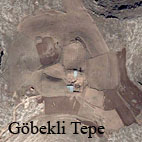 Göbekli
Tepe Göbekli
TepeEastern Anatolia "This site, currently undergoing excavation by German and Turkish archaeologists, was erected by hunter-gatherers at perhaps 11,500 B.C. (This is believed to be before the advent of sedentariness). It is currently considered the oldest known shrine or temple complex in the world, and the planet's oldest known example of monumental architecture." (http://www.realhistoryww.com/world_history/ancient/Anatolia_Turkey.htm) "Göbekli Tepe - One of the most exciting discoveries in Turkish archaeology this century. It currently stands as the oldest known Megalithic Temple complex in the world (9,000 BC). The site has numerous intricately carved T-shaped megaliths, covered with exquisite images of birds and animals." (http://www.ancient-wisdom.co.uk/turkey.htm) 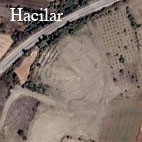 Hacilar HacilarSouthern Anatolia "Hacilar is an early human settlement in southwestern Turkey, 25 km southwest of present day Burdur. It has been dated back 7040 BC at its earliest stage of development. Archaeological remains indicate that the site was abandoned and reoccupied on more than one occasion in its history." (http://en.allexperts.com/e/h/ha/hacilar.htm) "Hacilar is another important center in Central Anatolia, near the modern city of Burdur. There is evidence there of agriculture dating back 9,000 years. Archaeologists have found considerable amounts of wheat, barley and lentils in the houses at Hacilar, giving clues to people’s diet and the history of domesticated foods. Catalhoyuk and Hacilar are also considered two of the earliest clay pottery centers. The existence of pottery is one very important indirect benefits of the sedentary lifestyle created by the ability to produce food year-round and even amass surpluses. Assured of their ability to eat, and able to feed more than just the people who produced food, these stone-age city dwellers had the opportunity and time invent and create." (http://www.crossculturedtraveler.com/archives/JAN2003/Turkey.htm)  Jericho JerichoEast Central Israel "Jericho is believed to be one of the oldest continuously-inhabited cities in the world, with evidence of settlement dating back to 9000 BC, providing important information about early human habitation in the Near East.[13] The first permanent settlement was built near the Ein as-Sultan spring between 8000 and 7000 BC by an unknown people, and consisted of a number of walls, a religious shrine, and a 23-foot (7.0 m) tower with an internal staircase." (http://en.wikipedia.org/wiki/Jericho) "The earliest settlement was located at the present-day Tell es-Sultan (or Tell Sultan), a couple of kilometers from the current city. Arabic tell means "mound" -- consecutive layers of habitation built up a mound over time, as is common for ancient settlements in the Middle East and Anatolia. The Neolithic settlements were contemporary with Catalhoyuk and had a similar technology level." (http://knowledgerush.com/kr/encyclopedia/Jericho/) "The next people who came to Ein es Sultan are called PPNA (The initials stand for Pre-Pottery Neolitiic A). They made their settlement at the spring around 8,000 BC. As the name indicates, they had no pottery. (Though as a well-preserved site at Catal Huyuk, Turkey shows they had wooden vessels). But the PPNA culture also raised their own domesticated wheat. (The bones of domesticated sheep and goats and the grains of domesticated wheat can be distinguished from the wild varieties easily.) The PPNA people built circular dome-shaped one-room huts of curved adobe bricks covered over with plastered mud. Similar circular huts are still built by peasants in northeastern Syria and southeastern Turkey. Sites of the PPNA culture are found all over Israel, Jordan, Syria, and northern Iraq and a similar early agricultural village of what was probably a closely related culture is found at Catal Huyuk in south-central Turkey. PPNA is the first agricultural society known. The spread of PPNA probably went along with the spread of a particular language across the Middle East, so PPNA culture was probably spread by one particular people who drove out or absorbed other peoples." (http://www.motherbird.com/jerichohst.html)  Metsamor MetsamorArmenia "Excavations have shown strata of occupancy going back to the Neolithic period (7,000-5,000 BC), but the most outstanding features of the site were constructed during the early, middle and late Bronze Ages (5,000-2,000 BC). Inscriptions found within the excavation go back as far as the Neolithic period, and a sophisticated pictograph form of writing was developed as early as 2000-1800 BC. The “Metsamor Inscriptions” have a likeness to later scripts. Metallurgy - The excavation has uncovered a large metal industry, including a foundry with 2 kinds of blast furnaces (brick and in-ground). Metal processing at Metsamor was among the most sophisticated of its kind at that time: the foundry extracted and processed high-grade gold, copper, several types of bronze, manganese, zinc, strychnine, mercury and iron." ªhttp://www.ancient-wisdom.co.uk/turkeymetsamor.htm) 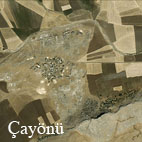 Çayönü ÇayönüEastern Anatolia "The Cayonu settlement which is not far from the city of Diyarbakir has been unearthed by the expedition teams under the leadership of Cambel, Braidwood, Mehmet Ozdogan, Wulf Schirmen and it is dated back to 7250-6750 BC. In the middle of the settlement is a center and around it are monumental, rectangular structures and houses. The foundation of the structures is stone and above is sun-dried brick. The inhabitants of Cayonu are the first farmers of Anatolia. They raised sheep and goat, and domesticated dog. The woman figurines among the finds discovered are the earliest traces of the Mother Goddess cult." (http://www.turizm.net/turkey/historyofturkeyNeolithic.html) If you try to find this site using Google Maps or Google Earth you will not be directed to the correct location. In fact both of those locations have differing references as to where Çayönü is located which is too far north for both. The above map is correct and the actual dig is at the top which has a small stream flowing through it and not at the center which is Sesverenpinar.  Jarmo JarmoZagros Mountains, eastern Iraq "Jarmo is an archeological site located in northern Iraq on the foothills of the Zagros Mountains. For a long time it was known as the oldest known agricultural community in the world, dating back to 7000 BC. It is also one of the oldest Neolithic village sites to be excavated. The Jarmo archeological site was one of the first means of documentation for the way of life of civilization's first farmers and herders. The people reaped their grain with stone sickles, stored their food in stone bowls, and possessed domesticated goats, sheep, and dogs. They also grew emmer and einkorn wheat, barley, and lentils. In addition to their agriculture, they also foraged for wild plants such as the field pea, acorns, pistachio nuts, and wild wheat. The later levels of settlement contained evidence of domesticated pigs and clay pottery. Since many of their tools were made of obsidian from beds 300 miles away, a primitive form of commerce must have existed. Bone tools, especially awls, were abundant from the site. Carefully made bone spoons and beads were also found." (http://www.mnsu.edu/emuseum/archaeology/sites/middle_east/jarmosite.html  Mehrgarh MehrgarhPakistan "Mehrgarh is a Neolithic (7000-3200 BC) site on the Kachi plain of Balochistan, Pakistan, and one of the earliest sites with evidence of farming (wheat and barley) and herding (cattle, sheep and goats) in south Asia. The site is located on the principal route between what is now Afghanistan and the Indus Valley. (http://wondersofpakistan.blogspot.com/2009/02/mehrgarh-lost-civilisation_22.html) A number of terracotta figurines have been found from sites in Mehrgarh dating from the fourth millennium BCE. These represent the earliest forms of female imagery (formerly believed to represent the 'mother goddess') found in the subcontinent (Elgood, p.331). (http://www.bukisa.com/articles/144874_archaeological-sites-mehrgarh-an-early-farming-community) If you go looking for this site you will find it difficult as the Google markers are too far north. This map is correct but even at a higher resolution the detail is not apparent. It could be that this image is too early in the archaeological process or there is not enough detail to see from satellite. 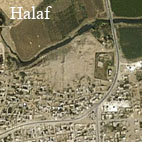 Halaf HalafNorthern Syria "In the period 6500–5500 B.C., a farming society emerged in northern Mesopotamia and Syria which shared a common culture and produced pottery that is among the finest ever made in the Near East. This culture is known as Halaf, after the site of Tell Halaf in northeastern Syria where it was first identified. The Halaf potters used different sources of clay from their neighbors and achieved outstanding elaboration and elegance of design with their superior quality ware. Some of the most beautifully painted polychrome ceramics were produced toward the end of the Halaf period. This distinctive pottery has been found from southeastern Turkey to Iran, but may have its origins in the region of the River Khabur (modern Syria). How and why it spread so widely is a matter of continuing debate, although analysis of the clay indicates the existence of production centers and regional copying. It is possible that such high-quality pottery was exchanged as a prestige item between local elites. The Halaf culture also produced a great variety of amulets and stamp seals of geometric design, as well as a range of largely female terracotta figurines that often emphasize the sexual features. Among the best-known Halaf sites are Arpachiyah, Sabi Abyad, and Yarim Tepe, small agricultural villages with distinctive buildings known as tholoi. These rounded domed structures, with or without antechambers, were made of different materials depending on what was available locally: limestone boulders or mud and straw. The Halaf culture was eventually absorbed into the so-called Ubaid culture, with changes in pottery and building styles." (http://www.metmuseum.org/toah/hd/half/ho_1986.311.1.htm)  Çatal
Hüyük Çatal
HüyükSouthern Anatolia "The best preserved early village so far uncovered [is] by Catal Huyuk in southern Turkey, excavated in 1961. The large, 32-acre site, first occupied shortly before 6000 B.C., contains some of the most advanced features of Neolithic culture: pottery, woven textiles, mud brick houses, shrines honoring a mother goddess, and plastered walls decorated with murals and carved reliefs. It is generally thought that because of their earlier role as gatherers of wild foods, women were responsible for the invention of agriculture. As long as the ground was prepared by hoeing rather than by plowing, women remained the cultivators. They also invented and performed the making of pots from clay, and the spinning and weaving of textiles from cultivated flax and animal wool." (http://www.nawpublishing.com/SumerianPublishing.htm) "The most developed examples of the Neolithic culture in Anatolia have been found in Catalhoyuk, the foundation of which dates back to 6500 BC. Great technological developments are observed in the working of obsidian and flint used for making tools in Catalhoyuk which was an urban settlement center and where there is also proof of foreign trade with neighboring countries." (http://www.mfa.gov.tr/grupc/ca/caa/uu/orta%20anadolu/catalhoyuk.htm)  Hamoukar HamoukarNorthern Syria "Archaeologists believe they have uncovered the world's oldest city in a remote part of Syria. Dating back to 6,000BC, the discovery is 2,500 years older than any known site and will prompt a dramatic reappraisal of ancient history. The huge settlement, called Hamoukar, is located between the Tigris and Euphrates rivers, an area known throughout ancient history as northern Mesopotamia. The city spread over 750 acres and is believed to have been home to up to 25,000 people. The discoveries will prompt a re-think of how mankind developed in the "cradle of civilisation" between the two great Middle Eastern rivers, the Euphrates and the Tigris. It was here that Babylon and Mesopotamia were established and the oldest known civilisation, the Sumerians, were identified to have lived around 3500BC. But Hamoukar is thought to have been constructed between 6000BC and 4000BC. At his office at the Museum of Raqqa, 300 miles north-east of the Syrian capital Damascus, Dr Maktash said the discovery would challenge conventional notions of the development of civilisation. "Hamoukar is at least 1,000 years older than Sumeria," he said. "But we don't know who the people were who lived at Hamoukar. If they were here first the big question is: where did the Sumerian civilisation come from - from nothing? It's possible they came from Hamoukar. This will change many things in our understanding of history." McGuire Gibson, professor of Chicago University's Oriental Institute, said: "We need to reconsider our ideas about the beginnings of civilisation, pushing the time further back. This would mean that the development of kingdoms or early states occurred before writing was invented." " (http://www.crystalinks.com/ud.html) 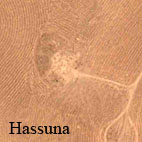 Hassuna HassunaNorthern Mesopotamia "Tel Hassuna is a Neolithic site found in the Assyrian region, located 22 miles south of Mosul in modern Iraq. In its prime, Tel Hassuna may have been surrounded by a stream on three sides. It is one of the earliest Mesopotamian sites, which dates back to late 7th millennium to late 6th millennium BCE, and is the type site for the Hassuna culture. These people, who used chipped stone hoes, represent some of the earliest farmers in northern Mesopotamia. There is evidence for the domestication of animals such as sheep, goats, and pigs. Hassuna inhabitants lived in houses made of tauf, or packed mud, surrounding open courtyards. In the central area of the site, the buildings were larger in size and seemed to have specific purposes other than housing inhabitants. Some material remains uncovered from previous excavations have included ovens used for baking, pots for grain storage possibly lined with bitumen or gypsum plaster to keep out moisture, and grinding stones to process grains such as emmer and barely. The pottery found at the site is called Hassuna pottery and is characterized by red slip on cream-colored clay. Herring-bone lines decorate the pottery. Stamp seals, which may have been used for indication of contents or ownership, usually accompany the pottery. There is evidence of turquoise in Hassuna, which would have been imported, and is an unusual find at early sites in Iraq. Other pottery included grey-burnished pieces which were probably attained through trade. At earlier levels there is a considerable amount of stone objects, flint, and obsidian. Beads, pendants, and other small pieces of jewelry have also been found. Evidence found at Tel Hassuna excavations indicates a reverence for the afterlife. A dozen pottery-jar infant burials have been found alongside more jars containing food and drink meant to sustain the child in the afterlife. Small figurines of a "mother-goddess" form made from reddish clay have been found. One figurine had a headdress created for her, molded from a type of green clay." (http://wikimapia.org/1877943/Tel-Hassuna) "The Tell Hassuna people had a neolithic culture in northern Mesopotamia. Their culture flourished about 6000-5250 B.C. We do not know what these people called themselves, so Tell Hassuna is a name given as a matter of convenience. They had no form of writing, so we do not know what their language was like. The Tell Hassuna people had a settled lifestyle. Their communities varied in size; the maximum population of their towns was about 500. Most were small villages that covered areas of 2-8 acres. The houses were rectangular and most had more than one room. Mudbrick formed the composition of most of the buildings. Residences typically had yards with walls around them. The residents did much of their cooking in outdoor ovens. However, there were also some indoor ovens with chimneys. Floors were plastered and niches in walls were used for storage. Farming provided much of the food. The Tell Hassuna people raised barley and wheat. They also did a considerable amount of hunting. The game that they hunted included onagers (wild donkeys) and gazelles. It is obvious that they did not domesticate donkeys or horses. Archaeologists have excavated several sites of this culture. Tell Hassuna is the largest community. It had some large central buildings that were divided into small square rooms. These structures had dirt floors and no hearths. The evidence indicates that they were used for storage. An archaeological team found 2,400 clay objects that are thought to have been projectiles propelled by slings. There were also about 100 large balls made of baked clay; these items may have been used as weapons. The inhabitants of the Tell Hassuna towns used stamp seals to make images on clay. They created an enormous amount of pottery. Alabaster and terracotta were commonly used for making pottery. Red paint was used to make linear designs on the pots, bowls, and goblets. Banded designs were common; the stripes were horizontal on some vessels and vertical on others. Many statuettes were created by the Tell Hassuna people. These figurines were often made of alabaster or terracotta. The small sculptures frequently represented female figures. I learned a considerable amount of information about the Tell Hassuna culture during my time as a graduate student at the University of Texas. The Tell Hassuna people were of the stone age, but were quite advanced for that time frame." Neal Robbins (http://www.infohub.com/forums/showthread.php?t=3438 Copyright © 2009 InfoHub.Inc)  Ubaid UbaidSouthern Mesopotamia "An understanding of the rise of complex cultures in southwest Asia should begin with the Ubaid Period which falls chronologically between the origins of agriculture and the rise of urbanism. During the Ubaid a new social order was evolving in southern Mesopotamia and the Susiana Plain (Elam) of SW Iran out of which emerged complex societies with a centralized state structure. During the fifth millennium BC Ubaid culture spread northward up the Tigris-Euphrates drainage as far west as Cilicia and the Amuq. This foreshadows a similar expansion of what has been interpreted as Uruk trading colonies or enclaves established to obtain essential raw materials lacking in the alluvial plain .....PreHistoric Ubaid Culture (5500-4000 BC) (http://ancientneareast.tripod.com/Ubaid_Culture.html)
"In
the
period 5500–4000 B.C., much of Mesopotamia shared a common
culture, called Ubaid after the site where evidence for it was first
found. Characterized by a distinctive type of pottery, this culture
originated on the flat alluvial plains of southern Mesopotamia (ancient
Iraq) around 6200 B.C. Indeed, it was during this period that the first
identifiable villages developed in the region, where people farmed the
land using irrigation and fished the rivers and sea (Persian Gulf).
Thick layers of alluvial silt deposited every spring by the flooding
rivers cover many of these sites. Some villages began to develop into
towns and became focused on monumental buildings, such as at Eridu and
Uruk. The Ubaid culture spread north across Mesopotamia, gradually
replacing the Halaf culture. Ubaid pottery is also found to the south,
along the west coast of the Persian Gulf, perhaps transported there by
fishing expeditions. Baked clay figurines, mainly female, decorated
with painted or appliqué ornament and lizardlike heads, have
been found at a number of Ubaid sites. Simple clay tokens may have been
used for the symbolic representation of commodities, and pendants and
stamp seals may have had a similar symbolism, if not function. During
this period, the repertory of seal designs expands to include snakes,
birds, and animals with humans. There is much continuity between the
Ubaid culture and the succeeding Uruk period, when many of the earlier
traditions were elaborated, particularly in architecture.
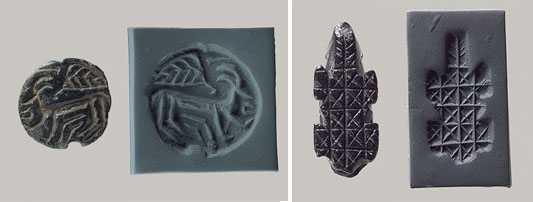
Left:
Stamp seal with animal and bird, 6th–5th millennium B.C.;
Ubaid period Syria or Anatolia.
Right: Stamp seal, 6th millennium B.C.; Halaf period Syro/Cilicia The impressing of carved stones into clay to seal containers had a long tradition in Mesopotamia, with the earliest evidence found in Syria dating to the seventh millennium B.C. During the Ubaid period, the variety of designs carved on seals expanded from simple geometric forms to include animals with humans, snakes, and birds. Seals like this one with deeply carved animal motifs became characteristic of northern Syria and southeastern Anatolia. It is decorated with a four-legged horned animal. Above the animal is a leaf shape, possibly a stylized bird, while two bent lines under its body may represent vegetation or perhaps snakes." (http://www.metmuseum.org/toah/hd/ubai/hd_ubai.htm)
"During
the 6th and 5th millennium BC the peoples of Ubaid Mesopotamia and the
Arabian Neolithic met and interacted. This was first realised during
the 1960's and 1970's, when numerous sites were identified in the
Central Gulf region which contained pottery in the Ubaid
style.
These were mostly coastal, and were mainly found in the northeastern province of Saudi Arabia, though sites were also identified in Bahrain and Qatar. The majority were small and ephemeral, but a handful were large, with deep deposits and abundant pottery. Abdullah Masry studied these sites (Masry 1974), and excavated three of the most promising ones (Abu Khamis, Dosariyah and Ain Qannas). Excavations also occurred at smaller Ubaid sites in Bahrain and Qatar (Roaf 1976; de Cardi 1978). Masry concluded that this part of Arabia had enjoyed a close and integral relationship with Southern Mesopotamia. More controversially, he suggested that the Mesopotamian and Ubaid-related Arabian sites should be regarded as part of the same social and economic system, and that the origins of Mesopotamian civilization lie as much in the Arabian Peninsula as in Mesopotamia. Meanwhile, Joan Oates and her collaborators proved through petrographic and compositional analysis that the Ubaid-style painted pottery from the Gulf states originated in Southern Mesopotamia (Oates et al. 1977). She had a simpler explanation than Masry, suggesting that Ubaid visitors travelled down the Gulf in search of fish and perhaps pearls, trading their pottery with local communities along the way." (http://www.ucl.ac.uk/archaeology/kuwait/backgrnd.htm) 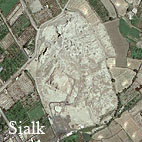 Sialk SialkCentral Iran "After three phases of excavations, the head of the team Roman Ghirshman published a book that amazed the academic society of the time. According to Ghirshman, sialk was the place where man first used a form of mortar in construction. It is also the first place where cloth-weaving, spooling and casting were invented. Evidence suggests that the site was not only the starting point of Persian civilization but also the first place where religious thought took form. Further studies by Iran's Cultural Heritage Organization revealed that sialk was as old as 7000 to 9000 years. Settlers first inhabited the region somewhere around 5500 B.C. - 6000 B.C., drawn to the region due to the abundant water supply provided by what is known today as Cheshmeh ye Soleiman (or 'Solomon's Spring'). (http://www.presstv.ir/detail.aspx?id=37364§ionid=3510304) 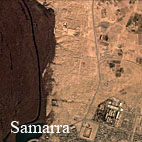 Samarra SamarraUpper Mesopotamia "Though the present archaeological site covered by mudbrick ruins is vast, the site of Samarra was only lightly occupied in ancient times, apart from the Chalcolithic Samarran Culture (ca 5500–4800 BC) identified at the rich site of Tell Sawwan, where evidence of irrigation—including flax— establishes the presence of a prosperous settled culture with a highly organized social structure. The culture is primarily known by its finely-made pottery decorated against dark-fired backgrounds with stylized figures of animals and birds and geometric designs. This widely-exported type of pottery, one of the first widespread, relatively uniform pottery styles in the Ancient Near East, was first recognized at Samarra. The Samarran Culture was the precursor to the Mesopotamian culture of the Ubaid period." (http://en.wikipedia.org/wiki/Samarra)
"Samarra
is now one of the largest
archaeological sites in the world."
(http://www.dur.ac.uk/derek.kennet/samarra.htm) 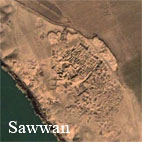 Sawwan SawwanUpper Mesopotamia "Archaeologists have found five levels of occupation at Tell es-Sawwan. The first two are designated as I and II; they are generally thought to be of the Tell Hassuna culture. These levels have a tripartite building plan. These tripartite buildings were made around a central room. It was divided into three parts and a corridor bordered it on each side. The areas were further subdivided into chambers. Some children's graves have been discovered in the floors. A number of goods were found with the remains of the children. These burial items consisted of pottery and figurines made of alabaster. Radiocarbon dating was made from a floor sample of level I; it was dated to 5506+73 B.C. A similar date (also taken from a floor) was given for Level II. In Level III the architecture has a different pattern. Level IIIA has T-shaped buildings with fortification features. These include walls, ramparts, and ditches. In Level IIIB the buildings are converted into granaries. The radiocarbon dating was made from a floor and is 5349+86 B.C. This level is dated to the Samarra period. [Note - The Samarra time frame is 5500-500 B.C.] I should mention that not all of the pottery of Level III is Samarra; some of it is Hassuna. Levels IV and V are also dated to the Samarra. A major change is apparent in Level IV. The fortifications are no longer used. Level V has been dated to the Halaf period." Neal Robbins (http://www.infohub.com/FORUMS/showthread.php?t=3440 Copyright © 2009 InfoHub.Inc) "Tell as-Sawwan was fortified early today in Iraq, 110 km northwest of Badgadista fairly close to Samarraa. Place is located in northern and central Mesopotamia frontier rain-growing border, south of .
This
early
settlement was the central Mesopotamia, the Tigris river,
archaeologists running of perhaps about 6300-6100 BC , Whose
inhabitants lived kasteluviljelyllä and store grain. Clay
utensils
and copper machining, cold, perhaps you know. Miniature judging
palvottiin men and women on fertility liiittyen so later than the
Middle East and elsewhere. Tel es-Sawwanin village joined the broader
Samarran culture, which is considered to be the Middle East
sivilisaatiokehityksen pre-operational phase. sawwan located in the
cultural area of the southern border."
Eridu - The First Known Sumerian City(http://fi.wikipedium.org/wiki/Tell_es-Sawwan - Translated) After the kingship descended from heaven, the kingship was in Eridu "I chose the archeological site Eridu, now known as modern Abu Shah Rain. Eridu is 196 miles southeast of Baghdad, Iraq. It was the earliest known city of Sumer (Southern Mesopotamia).There are also an important group of temples in Eridu (Britannica, 1999) Eridu was located by the mound called Abu Shayhrayan. This was one of the most important prehistoric urban centers in southern Babylonia. It was built on sand dunes probably in the fifth millennium B.C. It completely showed the sequence of the preliterate Ubaid civilization. Eridu had a long succession of super imposed temples portraying the growth and development of intricate mud brick architecture (Britannica, 1999). The apparent continuity of occupation and religious observance at Eridu provide convincing evidence for the indigenous origin of Sumerian civilization [emphasis added]. The site was excavated between 1946 and 1949 by the Iraq Antiquities Department (McDonald) The city continued to be occupied until 600 B.C. but was less important in historic periods." (http://www.mnsu.edu/emuseum/archaeology/sites/middle_east/eridu.html)
Same
map as on the previous page First Legend Maps
Three
famous cities now lost: Dilmun, Akkade and Aratta
http://firstlegend.info/theoldones.html
|
Σύμπαν και άνθρωπος
Όλα στο σύμπαν αφορούν τη μεταμόρφωση.Η ζωή μας μοιάζει με τις σκέψεις που τη διαμορφώνουν.
Μάρκος Αυρήλιος
Μάρκος Αυρήλιος
Παρασκευή 26 Απριλίου 2013
The Old Ones
Εγγραφή σε:
Σχόλια ανάρτησης (Atom)

Δεν υπάρχουν σχόλια:
Δημοσίευση σχολίου